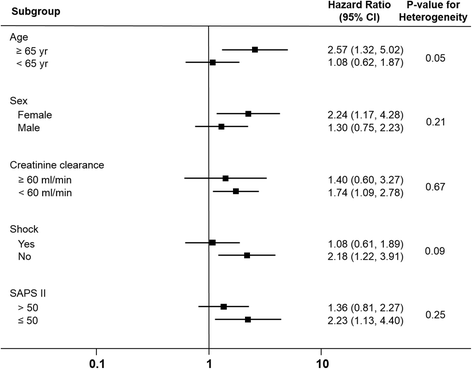Inhaled nitric oxide and the risk of renal dysfunction in patients with acute respiratory distress syndrome: a propensity-matched cohort study
- PMID: 27903300
- PMCID: PMC5131425
- DOI: 10.1186/s13054-016-1566-0
Inhaled nitric oxide and the risk of renal dysfunction in patients with acute respiratory distress syndrome: a propensity-matched cohort study
Abstract
Background: Inhaled nitric oxide (iNO) is a rescue therapy for severe hypoxemia in patients with acute respiratory distress syndrome (ARDS). Pooled data from clinical trials have signaled a renal safety warning for iNO therapy, but the significance of these findings in daily clinical practice is unclear. We used primary data to evaluate the risk of iNO-associated renal dysfunction in patients with ARDS.
Methods: We conducted a cohort study using data from a tertiary teaching hospital to evaluate the risk of incident renal replacement therapy (RRT) in iNO users compared with that of non-users. Propensity score matching and competing-risks regression were used for data analysis. Residual confounding was assessed by means of a rule-out approach. We also evaluated effect modification by pre-specified factors using stratified analysis.
Results: We identified 547 patients with ARDS, including 216 iNO users and 331 non-users. At study entry, 313 (57.2%) patients had moderate ARDS and 234 (42.8%) had severe ARDS. The mean patient age was 63 ± 17 years. The crude hazard ratio of the need for RRT in iNO users compared with non-users was 2.23 (95% CI, 1.61-3.09, p < 0.001). After propensity score matching, there were 151 iNO users matched to 151 non-users. The adjusted hazard ratio was 1.59 (95% CI, 1.08-2.34, p = 0.02). In the stratified analysis, we found that older aged patients (≥65 years) were more susceptible to iNO-associated kidney injury than younger patients (p = 0.05).
Conclusions: This study showed that iNO substantially increased the risk of renal dysfunction in patients with ARDS. Older aged patients were especially susceptible to this adverse event.
Keywords: Acute respiratory distress syndrome; Adverse effect; Nitric oxide; Renal failure; Treatment.
Figures



References
-
- Adhikari NK, Dellinger RP, Lundin S, Payen D, Vallet B, Gerlach H, Park KJ, Mehta S, Slutsky AS, Friedrich JO. Inhaled nitric oxide does not reduce mortality in patients with acute respiratory distress syndrome regardless of severity: systematic review and meta-analysis. Crit Care Med. 2014;42(2):404–12. doi: 10.1097/CCM.0b013e3182a27909. - DOI - PubMed
-
- Bellani G, Laffey JG, Pham T, Fan E, Brochard L, Esteban A, Gattinoni L, van Haren F, Larsson A, McAuley DF, et al. Epidemiology, patterns of care, and mortality for patients with acute respiratory distress syndrome in intensive care units in 50 countries. JAMA. 2016;315(8):788–800. doi: 10.1001/jama.2016.0291. - DOI - PubMed
-
- Meade MO, Jacka MJ, Cook DJ, Dodek P, Griffith L, Guyatt GH. Survey of interventions for the prevention and treatment of acute respiratory distress syndrome. Crit Care Med. 2004;32(4):946–54. doi: 10.1097/01.CCM.0000120056.76356.AD. - DOI - PubMed
MeSH terms
Substances
LinkOut - more resources
Full Text Sources
Other Literature Sources

